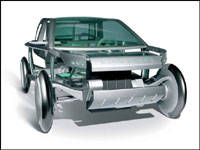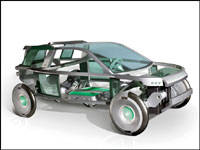Land_e's Technology to Take You to Greener PasturesThe Land Rover Land_e concept, shown at this year's Geneva Motor
 |
| Cutting back on emissions and fuel consumption is one of Land Rover's highest priorities. (Photo: Land Rover Canada) |
Show was developed to showcase Land Rover's plethora of new technologies. These technologies, collectively, are known as the e-Terrain System, which Land Rover claims will improve fuel economy, reduce CO
2 emissions, and maintain Land Rover's reputation as a capable 4x4 producer.
According to Land Rover, the e-Terrain System has the potential to improve fuel economy by 30 percent compared to a current production vehicle of similar size and performance. This new technology is also shooting for a CO
2 figure below 150 g/km, which would roughly equate to fuel consumption nearing the 5.65 L/100 km mark.
Two
 |
| 5.65 l/100 km in a Land Rover? Well, believe it. (Photo: Land Rover Canada) |
of the most practical innovations are the Integrated Electric Rear Axle Drive system, used in conjunction with the Integrated Starter-Generator. The Integrated Electric Rear Axle Drive system is applicable in both on- and off-road situations. During off-road use, the electric system provides excellent torque from a standstill position. Thus, offering the ability to effectively pull away when conditions are slippery or when towing. For more common on-road use, this system allows the vehicle to rely entirely on electric drive at low speeds, up to about 20 mph (32 km/h). So, when you are sitting in rush hour traffic, the Integrated Electric Rear Axle Drive will power the vehicle without restarting the conventional engine and therefore improve fuel economy and reduce CO
2 emissions. Great idea, but what if you need quick acceleration? This is where the Integrated Starter-Generator comes in. In the event the driver requires a little more get-up-and-go, this system automatically restarts the engine and drives the wheels using both conventional and electric power.
Does it sound like a conventional hybrid electric (HEV) system? It should, at least on the surface it mirrors Toyota's Hybrid Synergy Drive as applied to its Highlander Hybrid and Lexus RX 400h, which include a secondary electric motor dedicated to driving the rear wheels only, replacing the conventional all-wheel drive system and by so doing eliminating the need for a engine to rear differential driveshaft.
In the Land_e these two systems working together are supposed to provide
 |
| Land_e is a skeleton, but this matters little: the technology is valuable. (Photo: Land Rover Canada) |
a conventional driving experience while drastically improving fuel economy and reducing CO
2 emissions, just like Toyota's system. But wait, there's more. Land Rover has also implemented a number of other innovations that claim to assist in reducing environmental impact by maximizing the vehicle's overall efficiency. For example, the Seamless Re-connect system is one that reduces mechanical losses by disconnecting the drive to the rear wheels when it is not needed, such as on a dry surface. However, if the system detects a slippery condition, rear-drive will be re-engaged instantaneously to provide added traction. News flash! The Highlander and RX 400h do this too.
The
 |
| Electricity is a key part of Land_e's fuel savings. (Photo: Land Rover Canada) |
cooling system is controlled by Land Rover's Intelligent Thermal Programme (the latter word British for program). This system has a number of functions. First off, it uses normally wasted exhaust heat to speed the warm-up of the engine and gearbox from cold reducing friction losses. An electronically controlled thermostat and cooling circuit accurately controls the coolant temperature to keep the engine running closer to its optimum temperature which, in turn, increases engine efficiency. Finally, this system utilizes an electric water pump as opposed to a belt-driven pump. This electric pump is only operational when needed instead of running constantly, thus avoiding the inefficiency of running at high speeds.






